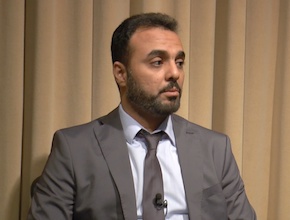References
Alhazzani W, Alenezi F, Jaeschke RZ, Moayyedi P, Cook DJ. Proton pump inhibitors versus histamine 2 receptor antagonists for stress ulcer prophylaxis in critically ill patients: a systematic review and meta-analysis. Crit Care Med. 2013 Mar;41(3):693-705. doi: 10.1097/CCM.0b013e3182758734. Review. PubMed PMID: 23318494.Cook DJ, Fuller HD, Guyatt GH, et al. Risk factors for gastrointestinal bleeding in critically ill patients. Canadian Critical Care Trials Group. N Engl J Med. 1994 Feb 10;330(6):377-81. PubMed PMID: 8284001.
Roman Jaeschke: Dr. Alhazzani, another topic which I wonder if you could get us a little clarification of. During the last Surviving Sepsis Campaign, one of the bigger controversies were surrounding gastrointestinal (GI) prophylaxis in critically ill patients. You authored a subsequent meta-analysis on the subject. You will be involved in the new guidelines. I wonder again whether you could tell us your own views on stress ulcer prophylaxis in critically ill patients.
Waleed Alhazzani: Of course. The previous Surviving Sepsis Guideline recommended using stress ulcer prophylaxis in patients who are septic with risk factors for stress ulcers. We know the most important risk factors, proven by the prior work of Dr. Cook at McMaster, are (a) mechanical ventilation for more than 48 hours, and (b) being coagulopathic. There are other observational studies that show there may be other associations but they were less strong; probably the studies were not as strong or as large as the study done by Dr. Cook. So, number 1: I think that patients who have risk factors probably may benefit from being prescribed stress ulcer prophylaxis.
The second question is which agent should we use. There has been a lot of debate. This is reflected in the surveys from the last 20 years, since the release of proton pump inhibitors (PPIs) into the market. H2-blockers were the most commonly used agents. With time you can see the trends reversing. The most recent surveys in North America show that 70% of the ICUs, at least involved in the study, were using PPIs and about 30% of the ICUs were using H2-blockers. And why people are using PPIs more often? Cause we know that from a recent meta-analysis that we published in Critical Care Medicine, which showed that PPIs reduce the risk of clinically important bleeding compared to H2-blockers. So they do have some clinical benefit. And there was no significant increase in the risk of pneumonia, although I have to admit that the quality of studies and the quality of the evidence probably was low. We still have some uncertainties in that regard. Surprisingly, there were no randomized controlled trials (RCTs) looking at Clostridium difficile infection (CDI). There have been lots of observational studies done in outpatient or inpatient population as well as in the ICU. The most recent was a retrospective study with more than 30,000 patients from the United States that looked at these specific questions: “Do PPIs increase the risk of CDI compared to H2-blockers?” and they found that there is doubling of the risk of CDI in patients who receive PPIs. Again, low quality of data, the treatment effect was small, and the risk increase was minimal.
RJ: In absolute terms?
WA: Yes. Whether to believe these data or whether this is going to change the practice, we are still discussing this in the Surviving Sepsis group. In my own belief, I would still use PPIs because we have high certainty that it does work and it does reduce the risk of bleeding. Until we have a strong evidence showing harm of PPIs, I would not abandon the use of PPIs. I think we still need well-done or larger studies looking at this specific question in order for us to change practice.
RJ: You mentioned risk factors in terms of coagulopathy. Could you tell us more specifically what it means?
WA: I am referring to the study published by Dr. Cook years ago, and they looked at specifically the INR levels and thrombocytopenia: thrombocytopenia less than 50,000 or an INR level more than 1.5, basically.
RJ: Dr. Alhazzani, if I hear you correctly, you would still use the GI prophylaxis or PPI prophylaxis in people who have either coagulopathy or have respiratory failure who are septic. Does the fact that some of them are fed or not fed influence your choice?
WA: That is a very important question. The impact of enteral feeding as a prophylactic agent or intervention in patients who are in the ICU has been shown in few observational studies. The only RCT I am aware of was done in the burn population and was a small-sized RCT looking basically at feeding plus arginine. There were few before and after studies looking at enteral feeding and the effect on stress ulcer prophylaxis. We do have some low quality of evidence suggesting that it might contribute to the lower incidence of bleeding that we see nowadays compared to years ago, when patients were not fed enterally earlier in the ICU. So we did notice that the incidence of bleeding has come down significantly over the last 20 to 30 years.
Coming back to your question, I do not think we have data enough to answer your question directly, but I would still use PPIs in patients, especially high-risk patients, regardless of the fact whether they receive enteral feeding or not.
RJ: Thank you. Very useful! Thank you very much, Dr. Alhazzani.
WA: Thank you. My pleasure.
 English
English
 Español
Español
 українська
українська







